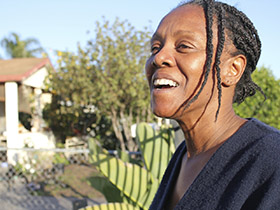By Melissah Yang
Contributor
Every month for the past four years, Donna Alexander has gone to the food line down the street from her home in South Los Angeles. Sometimes, she waits in line. Other times, she helps pass out food.
This month, she does both.
 Donna Alexander (Photo by Melissah Yang)
Donna Alexander (Photo by Melissah Yang)Alexander, 59, first takes a bag of food for herself and then grabs more bags for her neighbors who have trouble walking and can’t leave their homes. After checking in with them, she returns to the corner of 79th Street and Vermont Avenue to help manage the food line in front of New Antioch Church of God in Christ.
“I guarantee you, for everybody that was in that food line, they can tell you where 10 other food lines are, what days they are and what times,” Alexander said. “Those are the people that live and breathe on food lines because they have no choice.”
According to the most recent figures from the U.S. Census Bureau, about one out of three people in South L.A. are living below the poverty line, double the average for Los Angeles County. More and more people in South L.A., including Alexander, have to depend on food lines to stock their refrigerators.
Alexander says she feels lucky compared to others so she does her best to help her neighbors when she can. Everyone on South L.A.’s 79th block knows that the front door of her home is always open. When a neighbor calls out, “Donna, Donna,” from the sidewalk, she walks out to see what she can do.
Alexander says her role of helping others is like a full-time job.
But that job doesn’t pay, and Alexander is still unemployed after being laid off as a counselor for parolees with drug and alcohol addictions two years ago. Since having a stroke in 2000, Alexander has struggled with maintaining a job. She supports herself and her 19-year-old son, Le’Ron, who also can’t find work, through disability checks from Social Security’s Supplemental Security Income program.
James Kornegay, who runs New Antioch’s monthly food line, drove to two food banks earlier in the week to collect three truckloads of groceries in order to help feed the neighborhood.
While church members put whole frozen chickens, beef patties, bread and juice into brown paper bags, Kornegay holds up a sign-in sheet with a list of people’s names, addresses and family sizes. He passes out the first bag of food promptly at 9:00 a.m., although people began to line up two hours earlier.
“Food is an issue,” Kornegay said. “These families are making $25,000 to $30,000 a year for six people. They just need a little help.”
Alexander says the issue isn’t whether food is easily accessible. There are two grocery stores within half a mile of Alexander’s home. The problem, she says, is that her neighbors can’t afford to shop there.
And to further save money, families and friends are living under the same roof.
The average household size in South L.A. is 3.39 people, according to the U.S. Census Bureau, almost one person more than the average American household. A bigger household means more mouths to feed, and South L.A.’s high unemployment rate of 12.9 percent – five percentage points higher than the national rate – is not only leaving people without work, but also keeping food off of tables.
New Antioch’s Senior Pastor, Jeffrey M. Lewis, says the economic difficulties of the past few years hit South L.A. especially hard. New Antioch’s food line has always been busy, but now it wraps around the corner every month.
“When the recession hit, people who had normal blue-collar jobs lost them,” Lewis said. “They don’t have college degrees so they were just left hanging.”
Alexander points out that the people who are in the food lines aren’t homeless. She says that they just don’t have enough money to feed their families.
Alexander spends two-thirds of her social security income on rent and utilities. Without the lines, Alexander says she would have to spend another $75 per week on food, money that she says she does not have.
“Now, where do groceries come in at? So, what else are we gonna do but get in the food line,” Alexander said.









 But on Sunday, Jan. 23, a different crowd gathered at St. Francis. The center was filled with people dressed in their Sunday best and traveled from all over Los Angeles. They were donors, friends and family, there to attend a celebratory mass and brunch in honor of the new Executive Director, Jill Remelski, and the transition of the former Executive Director to the President of the Board of Directors, Gerald A. Gumbleton.
But on Sunday, Jan. 23, a different crowd gathered at St. Francis. The center was filled with people dressed in their Sunday best and traveled from all over Los Angeles. They were donors, friends and family, there to attend a celebratory mass and brunch in honor of the new Executive Director, Jill Remelski, and the transition of the former Executive Director to the President of the Board of Directors, Gerald A. Gumbleton..jpg)






